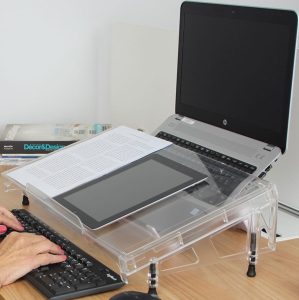
Why a fully adjustable office chair is important
We are all different, so when you buy a new office chair, look for one that has all the adjustability features.
As remote work becomes more common, having a dedicated and well-designed home office setup is essential. A functional workspace improves productivity, reduces distractions, and enhances overall wellbeing. Whether you’re working from home full-time or occasionally, setting up your home office correctly can make a significant difference.
Your home office setup will have a huge impact on how much work gets done and how you feel, both physically and emotionally.
Here are the 9 important steps to guide you in setting up your perfect home office.
The ideal home office setup starts with selecting the right spot. If possible, choose a quiet area away from high-traffic spaces.
Naturally, a dedicated room is best, but if space is limited, a quiet corner with minimal distractions can work just as well.

Your chair and desk are the foundation of your home office setup. Investing in an ergonomic office chair that supports your back and promotes good posture is crucial. 5 Best Ergonomic Office Chairs for Long Work Sessions
An adjustable standing desk can also help you switch between sitting and standing, reducing strain and improving circulation. The 7 Advantages of a Standing Desk
The correct setup your chair and desk in your home office is the key to maintaining good posture and preventing discomfort and lower back pain.
Watch our short video that shows you exactly how to adjust your chair and desk for optimum comfort.
First and foremost....move the chair AWAY FROM THE DESK.
Once you have set up the height of your chair correctly, move it towards the desk.
Your desk or table is the next component in your home office that needs attention. Adjust the height of the desk to approximately the height of your elbows.
Slay Study Sessions & Save Your Spine: Why an Ergonomic Study Chair Matters
Position your monitor at eye level, about an arm’s length away, to prevent neck strain. The top of the screen should be at or slightly below eye level.
Natural light is ideal for reducing eye strain and boosting mood.
Position your desk near a window if possible. If natural light is limited, use a combination of ambient and task lighting to create a well-lit workspace. A modern LED desk lamp with adjustable brightness can help reduce glare on screens.

A smooth-running home office setup requires the right technology.

A clutter-free desk enhances focus and efficiency.
Use storage solutions such as shelves, filing cabinets, and cable management tools to keep your workspace tidy. A home office with a minimalist setup tends to promote better concentration and creativity.
Adding personal touches makes your home office more inviting. Consider incorporating plants, artwork, or decorative elements that inspire you in your home office setup.
Small decorative objects on your desk or bookshelves, scattered cushions in your favourite pattern, plants and/or your favourite flowers and modern lights, are simple ways to reflect your individuality.

If external noise is an issue, consider using noise-cancelling headphones, soundproof curtains, or a white noise machine. Setting boundaries with family members, pets or housemates can also help maintain a quiet workspace.
A great home office setup goes beyond furniture and technology. Establishing a work routine is crucial for maintaining productivity. Stick to a consistent schedule, take regular breaks, and incorporate movement and exercise throughout the day to avoid burnout.
Job burnout: How to spot it and take action
Creating the perfect home office setup requires thoughtful planning and investment in the right tools. By choosing an optimal location, investing in ergonomic furniture, and maintaining an organised and comfortable space, you can create a productive and enjoyable work environment. A well-designed home office enhances focus, efficiency, and overall job satisfaction, making remote work more effective and enjoyable.

We are all different, so when you buy a new office chair, look for one that has all the adjustability features.

Ergonomic and orthopedic office chairs are very similar. What are the major differences and which is best?

One of the best ergonomic accessories you can get is a document holder.


